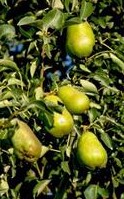 Pears are in the genus Pyrus and family Rosaceae. Shakespeare’s pear was probably the common pear (Pyrus communis) which is native to central and Europe, and southwest Asia. They are trees 25-30’ in height and have elliptic glossy dark green leaves up to four inches long. In fall the leaves turn yellow to red. The creamy white flowers have five petals and are sometimes flushed with pale pink. They are borne in corymbs in early spring. Pears like moist, well-drained soil and full sun. They are not as hardy as apples but are a bit less disease prone.
Pears are in the genus Pyrus and family Rosaceae. Shakespeare’s pear was probably the common pear (Pyrus communis) which is native to central and Europe, and southwest Asia. They are trees 25-30’ in height and have elliptic glossy dark green leaves up to four inches long. In fall the leaves turn yellow to red. The creamy white flowers have five petals and are sometimes flushed with pale pink. They are borne in corymbs in early spring. Pears like moist, well-drained soil and full sun. They are not as hardy as apples but are a bit less disease prone.
Shakespeare mentions pears in four plays.
The scoundrel Flagstaff in Merry Wives of Windsor (act iv, sc 5, 101) muses to himself;
I warrant
they would whip me with their fine wits till I were
as crest-fallen as a dried pear.
In All’s Well that Ends Well (act 1, sc. 1, 174) the braggartly Parolles tells the heroine, Helena;
your virginity,
your old virginity, is like one of our French
withered pears, it looks ill, it eats drily; marry,
’tis a withered pear; it was formerly better;
marry, yet ’tis a withered pear: will you anything with it?
The Clown in The Winter’s Tale(act iv. Sc. 3, 48) goes over his shopping list for the sheep-shearing feast;
I must have saffron to colour the warden
pies;
In Romeo and Juliet (act ii, sc. 1, 37) Mercutio says to Benvolio as they look for their good friend Romeo;
Romeo, that she were, O, that she were
An open et caetera, thou a poperin pear!
Pears were known in ancient times. Homer mentions them together with apples and figs in the Odyssey and Theophrastus of Eresos (370–286 BC) gives information on cultivation as do the Romans Marcus Procius Cato (234–149 BC) who also describes six kinds of pears, Marcus Terentius Varro (116–27), and Pliny the Elder (23–79) who identifies over 40 different varieties. Augustine (354–430) of Hippo cites the pear as an object of temptation and the Frankish king Charlemagne (742–814) is known to have established first the collection of pears. By Shakespeare’s time the pear was well known and grown in England. The botanist John Gerard, a contemporary of Shakespeare notes that every country had their own particular kind of pear.
Shakespeare mentions two specific kinds: the warden and the poperin. According to some authorities, the warden got its name from the Anglo-Saxon wearden, meaning to preserve. Others think the name comes from the Cistercian monks’s Wardon Abbey that has three pears in its aarmorial bearings of the abbey. The warden pear is long lasting and is usually roasted or baked. The firm, dry Poperin pear may have been Flemish and named after the Rector of Popering who introduced it. Shakespeare’s use of the Popering pear (in Romeo and Juliet) was probably as a euphemism for penis.